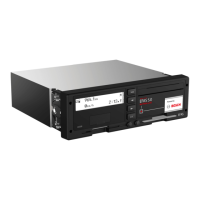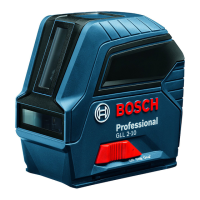81
Workshop Manual
Smart Tachograph EFAS-4.10/4.11
13.1.4 CAN parameters
If the A plug connector’s CAN bus is to be used, a number of parameters must be set, so that the CAN bus fullls the specic
requirements of the respective vehicle type.
The following functions are set with these parameters:
y Transmission rate (125 kbps, 250 kbps or 500 kbps)
y Length of CAN identier (11 bits or 29 bits)
y Protocol selection “Standard protocol”
y Protocol selection “Diagnostic protocol”
y Transmission interval of the “TCO1” message (20 ms or 50 ms)
29
y Priority of the “TCO1” message
y Heartbeat monitoring of a connected bus subscriber (ON or OFF)
y Error management after ignition ON
y Message timeout
y Sampling point
y Bus synchronization setting
Standard CAN parameters (main vehicle bus)
The parameters in the following table are dened as per ISO 16844-7 for the conguration of the main vehicle bus. In particular,
the most frequently required of these parameters (RDI=0xF90C and RDI=0xF920) are supported by standard testing / calibra-
tion devices.
Table 19 — Standard ISO 16844-7 CAN parameters
Parameter, main vehicle bus Ranges of values typical RDI hex
Heart beat monitoring of a connected bus subscriber ON/OFF OFF F90C
Transmission interval of the “TCO1” message 20 ms / 50 ms 50 ms F920
Priority of the “TCO1” message
30
0 to 7 3 F90F
Synchronization settings (SJW value)
30
1 TQ to 4 TQ 2 F979
Bit sampling instant
30
80% to 88% 87,2%
31
83,3%
31
88,9%
31
F97A
Timeout factor for messages
30
0 to 125 s 3 F97B
Error management after ignition ON
30
0 to 25.0 s 2,0 F97C
The following describes the meaning of the most important parameters.
Heart beat monitoring of a connected bus subscriber
Many instrument clusters or speedometer displays send a CAN message once per second as a heartbeat. This message can be
monitored by the tachograph. In case of failure of the message (malfunction), the tachograph logs the event and stores an error
code (DTC) in the error memory. If the instrument does not have a heart-beat function, the monitoring should be disabled with
parameter RDI=0xF90C to prevent entries being written to the error memory.
Transmission interval of the TCO1 message (20 ms / 50 ms)
The “TCO1” message is transmitted cyclically from the tachograph. It contains, among other things, the current vehicle speed as
displayed on the instrument cluster. The transmission interval is either 20 ms or 50 ms as dened by the vehicle manufacturer,
and so this value should be adjusted to the manufacturer’s specications accordingly.
A cycle rate that is too fast for the vehicle (20 ms) can cause that the functions of other control units at the CAN bus are aected.
This can lead to general malfunctions in the vehicle for example a malfunction of the ACC device. On the other hand, too slow
a cycle time (50 ms) can be interpreted as a malfunction of the tachograph in vehicles requiring the faster cycle rate. The trans-
mission interval is set with the parameter RDI=0xF920.
Manufacturer-specic CAN parameters
The CAN parameters in the following table are manufacturer-specic parameters, supported only by the tachograph EFAS, for
the conguration of CAN buses at the A plug connector and the C plug connector. These parameters can be set via testing / cal-
ibration devices which support EFAS extended parameter set. All of the parameters listed can be set with the EFAS Service Tool.
29 On the CAN-AUX bus (RDI=xFDB9), the TCO1 message can also be deactivated by entering the send interval TCO1 message = 0.
30 These values are not normally changed.
31 Hardware typical possible values at data rates of 250 and 500kbps

